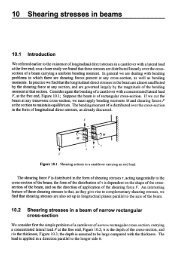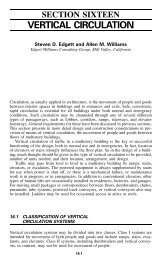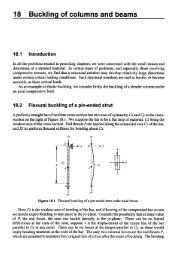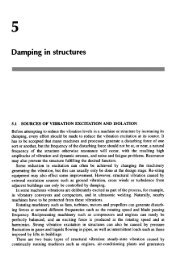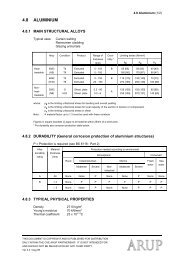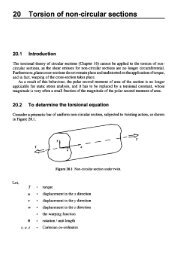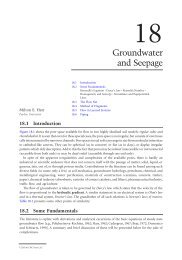Chapter 32 - Deep Foundations - Index of - Free
Chapter 32 - Deep Foundations - Index of - Free
Chapter 32 - Deep Foundations - Index of - Free
- No tags were found...
Create successful ePaper yourself
Turn your PDF publications into a flip-book with our unique Google optimized e-Paper software.
The merit <strong>of</strong> a deep foundation over a shallow foundation is manifold. By involving deepergeologic materials, a deep foundation occupies a relatively smaller area <strong>of</strong> the ground surface. <strong>Deep</strong>foundations can usually take larger loads than shallow foundations that occupy the same area <strong>of</strong>the ground surface. <strong>Deep</strong> foundations can reach deeper competent layers <strong>of</strong> bearing soil or rock,whereas shallow foundations cannot. <strong>Deep</strong> foundations can also take large uplift and lateral loads,whereas shallow foundations usually cannot.The purpose <strong>of</strong> this chapter is to give a brief but comprehensive review to the design procedure<strong>of</strong> deep foundations for structural engineers and other bridge design engineers. Considerations <strong>of</strong>selection <strong>of</strong> foundation types and various design issues are first discussed. Typical procedures tocalculate the axial and lateral capacities <strong>of</strong> an individual pile are then presented. Typical proceduresto analyze pile groups are also discussed. A brief discussion regarding seismic design is also presentedfor its uniqueness and importance in the foundation design.<strong>32</strong>.2 Classification and Selection<strong>32</strong>.2.1 Typical <strong>Foundations</strong>Typical foundations are shown on Figure <strong>32</strong>.1 and are listed as follows:A pile usually represents a slender structural element that is driven into the ground. However, apile is <strong>of</strong>ten used as a generic term to represent all types <strong>of</strong> deep foundations, including a(driven) pile, (drilled) shaft, caisson, or an anchor. A pile group is used to represent variousgrouped deep foundations.A shaft is a type <strong>of</strong> foundation that is constructed with cast-in-place concrete after a hole is firstdrilled or excavated. A rock socket is a shaft foundation installed in rock. A shaft foundationalso is called a drilled pier foundation.A caisson is a type <strong>of</strong> large foundation that is constructed by lowering preconstructed foundationelements through excavation <strong>of</strong> soil or rock at the bottom <strong>of</strong> the foundation. The bottom <strong>of</strong>the caisson is usually sealed with concrete after the construction is completed.An anchor is a type <strong>of</strong> foundation designed to take tensile loading. An anchor is a slender, smalldiameterelement consisting <strong>of</strong> a reinforcement bar that is fixed in a drilled hole by groutconcrete. Multistrain high-strength cables are <strong>of</strong>ten used as reinforcement for large-capacityanchors. An anchor for suspension bridge is, however, a foundation that sustains the pullingloads located at the ends <strong>of</strong> a bridge; the foundation can be a deadman, a massive tunnel, ora composite foundation system including normal anchors, piles, and drilled shafts.A spread footing is a type <strong>of</strong> foundation that the embedment is usually less than its smallest width.Normal spread footing foundation is discussed in detail in <strong>Chapter</strong> 31.<strong>32</strong>.2.2 Typical Bridge <strong>Foundations</strong>Bridge foundations can be individual, grouped, or combination foundations. Individual bridgefoundations usually include individual footings, large-diameter drilled shafts, caissons, rock sockets,and deadman foundations. Grouped foundations include groups <strong>of</strong> caissons, driven piles, drilledshafts, and rock sockets. Combination foundations include caisson with driven piles, caisson withdrilled shafts, large-diameter pipe piles with rock socket, spread footings with anchors, deadmanwith piles and anchors, etc.For small bridges, small-scale foundations such as individual footings or drilled shaft foundations,or a small group <strong>of</strong> driven piles may be sufficient. For larger bridges, large-diameter shaft foundations,grouped foundations, caissons, or combination foundations may be required. Caissons, largediametersteel pipe pile foundations, or other types <strong>of</strong> foundations constructed by using the c<strong>of</strong>ferdammethod may be necessary for foundations constructed over water.© 2000 by CRC Press LLC




